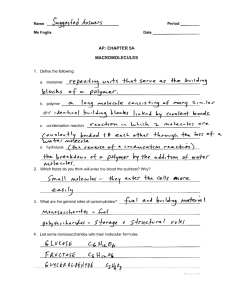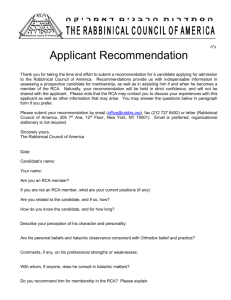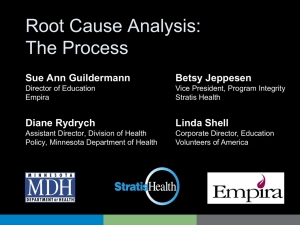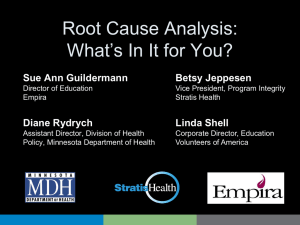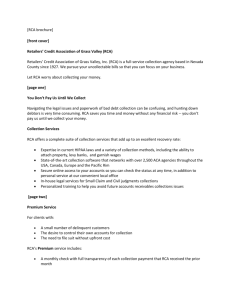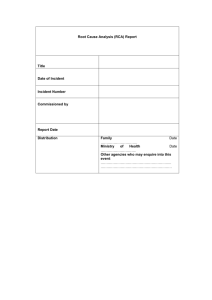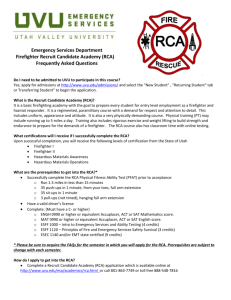2007 Dartmouth CLARION Root Cause Analysis Team
advertisement
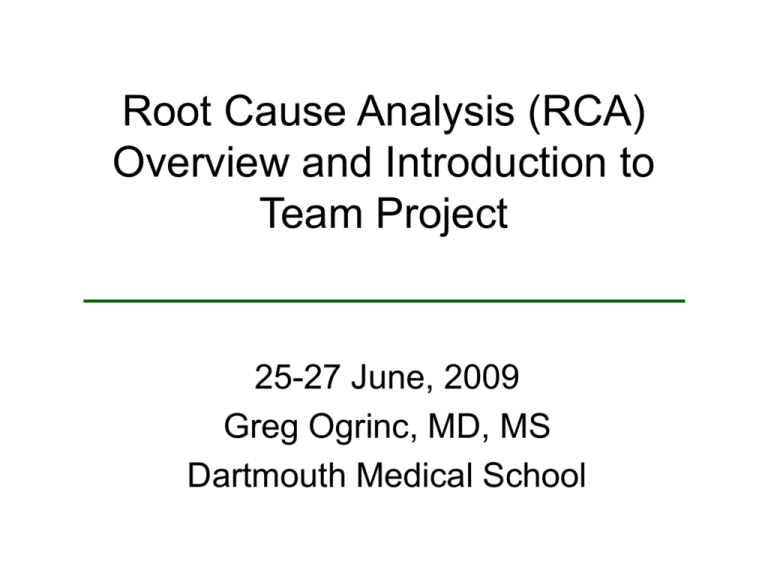
Root Cause Analysis (RCA) Overview and Introduction to Team Project 25-27 June, 2009 Greg Ogrinc, MD, MS Dartmouth Medical School Objectives • Meet, get to know, and work with some colleagues from other healthcare professions • Understand the background and theory of root cause analysis as a tool for investigating medical error • Develop one set of skills – root cause analysis – to analyze medical errors Agenda 1. What is a root cause analysis (RCA)? Why is it important? (15 min) 2. Interprofessional teamwork and communication (10 min) 3. University of Minnesota CLARION RCA competition (5 min) 4. Mini-RCA (45 min) 5. Instructions to teams and getting started (15 min) Case Examples • A young man arrives in the emergency department with chest pain. He has no family history of heart conditions and is outside the typical age range for heart attacks. His electrocardiogram is normal, and he reports that he has been moving furniture the past few days. The physician on duty concludes that this is a muscular injury, prescribes Motrin and rest, and discharges the patient. Unfortunately, the patient returns several hours later with a full-blown heart attack and in shock. • A nurse is asked to give a patient a particular IV antibiotic. She grabs the wrong antibiotic from the cabinet and administers a different IV medication instead. http://www.ihi.org/IHI/Programs/IHIOpenSchool/ Blame and Punishment… • These are the traditional responses to error • 5% error from incompetent or poorly intended care • 95% from conscientious and competent individuals involved in circumstances that led to a catastrophic result • Must differentiate between unintentional situations and deliberate ones – Impaired by alcohol or drugs – Criminal acts Systems Approach to Safety • Latent errors (after James Reason, 1990) – defects in the design and organization of processes and systems that can lead to failures and errors – often unrecognized or just become accepted aspects of the work Vincent, NEJM, 2003 Principles for Understanding System Failure • Search for underlying cause • Causes can be reasonably identified – Not intended to be a search for buried treasure • System causes can be modified by leaders/managers • Effective recommendations can be generated Rooney and Vanden Heuval, Qual Progress, 2004 Taxonomy and Types of Errors • Skill-based errors – slips and lapses – when the action made is not what was intended • Rule-based mistakes – actions that match intentions but do not achieve their intended outcome due to incorrect application of a rule or inadequacy of the plan • Knowledge-based mistakes – actions which are intended but do not achieve the intended outcome due to knowledge deficits http://patientsafetyed.duhs.duke.edu/module_e/types_errors.html Core Concepts of Root Cause Analysis (RCA) • Improve rather than blame • Attend to the emotions of all the individuals involved • Recognize a series of causes (not just the proximal one) • Look forward for improvements – More than just an autopsy of a mistake Root Cause Analysis A method for identifying the basic or contributing causal factors that underlie variations in performance associated with adverse events or close calls – Interprofessional team – Focus on systems – Digs deep into the whats, hows, and whys of the case – Identify actions to prevent the error from occurring in the future Indications for an RCA • A serious event that has recently occurred, • A serious near-miss • An event associated with a bad/potentially bad outcome • Negligence or criminal activity is not clear Elements/Process of an RCA • Team: interprofessional group of people work to understand what happened and why • Time: time and effort are required • Trip: walking through the event and the physical location of the event(s) • Talk: conversation with those involved • Report: Writing a summary – What happened? – What were the causes and vulnerabilities? – Recommendations for changes/improvements. RCA Basic Process 1. Data collection – The team must understand and agree upon the events and sequence of events that occurred 2. Causal factor charting – Begin to organize possible causes using process modelling 3. Root cause identification – Draw conclusions, write root cause statements 4. Recommendations – How will we prevent this in the future? How can we monitor/measure our progress? RCA Process QI staff identifies the case Identify actions Case summary given to team Team reviews case with standard methodology Write root cause statements Gathers additional information (interviews, chart review, discuss with experts in the field) RCA in Real Life • Time limit of 45 days to complete • Team members – Chosen from many professions – Relieved of some other duties to participate – Not involved in the event • RCA review and recommendations go to the top of the organization Patient Safety in Wales • Improving Leadership for Quality • Reducing Healthcare Associated Infections • Improving Critical Care • Improving Medicines Management • Reducing Surgical Complications • Improving General Medical and Surgical Care Pitfalls to Avoid • Jumping to premature solutions • Spending too much time on what and not enough time on the why • Not using all the triggering questions • Getting stuck on the “clinical” part of the case • Focusing on blame • Ignoring the cost implications of your recommendations Interprofessional teamwork Why is teamwork important in healthcare? Evidence from Surgery, Medicine, Emergency Medicine • Gawande – 43% adverse events from communication failures w/ 2 or more clinicians • Risser* – 54% of tort claims from ED due to “teamwork failure” • Sutcliffe – interviewed 85 medicine residents – communication failure 70 AEs *MedTeams Research Consortium Medical Team Training Rules of Conduct • • • • • • • Respect each person Share responsibility Criticize only ideas not people Keep an open mind Question and participate Attend all meetings Listen constructively Two-Attempt Rule • Goal is to assure critical information is communicated to the right person – 1st assertive statement • 2nd assertive statement is made if a team member does not respond to the first • If no effective resolution after two attempts – Reflect back what you hear them telling you. – Request additional input, or, in rare cases, go up the chain of command to express concerns. • Eg. If a surgeon persists in going ahead with a case despite reservations from the circulating nurse or anesthesiologist, call in the chief of staff to resolve the situation Rules of Conduct Exercise • Think about how these rules of conduct would work for you • Pair- Turn to your neighbor and • Share an example of a situation where a rule of conduct might have helped with a difficult situation. – For example, one team member is continually late to briefings or meetings. What rule would have helped? How could you have used it to manage that situation? Workload Distribution • Someone must take charge! – Can rotate the leadership role – Helpful to have a timekeeper (“We’ve agreed to work together until 5:30pm, it is now 5:25pm, we should wrap up”) • Ensure input from all members of the team • Balance the burden of tasks to achieve optimal outcomes Techniques for Clear Communication • Read Back – Write what you heard – Read back what you wrote – Confirm with the sender • Repeat Back – Reflect back what you hear – Confirm with sender CLARION • CLARION creates and conducts co-curricular, interprofessional experiences for U of Minnesota Academic Health Center students • A catalyst, inspiring faculty to reexamine traditional curricula and seek ways to integrate interprofessional opportunities into the education and experience of students. • http://www.chip.umn.edu/CHIP/committees/clario n.html Questions? Comments? Agenda 1. What is a root cause analysis (RCA) and why is it important? (15 min) 2. Interprofessional teamwork and communication (10 min) 3. University of Minnesota CLARION RCA competition (5 min) 4. Mini-RCA (45 min) 5. Instructions to teams and getting started (15 min) Mini-RCA – Part 1 • • Case from the VA National Center for Patient Safety Work in your groups 1. Read the case, agree on the facts 2. Use triage questions to determine where you want to find more information 3. Create a list of next steps Mini-RCA – Part 2 • You now have more information about the case • Review the 5 rules of causation in the RCA triage packet • Write one root cause statement – Avoid negative descriptors “The [noun or activity or lack of activity] [increased, decreased, contributed to] the likelihood that [name the outcome].” Suggested RCA Statements • “The lack of in-service training on the monitor contributed to the likelihood that the demo mode was not recognized.” • “The level of clinical assessment training increased the likelihood that the EMTs would delay using manual, rather than electronic, assessments.” Instructions to the Groups • Read the case – Agree on the facts and the timeline of the case • Perform a mini root cause analysis to identify system vulnerabilities in the case – Recommend changes to prevent this event(s) from occurring in the future – Include a financial assessment • Prepare a 5 minute presentation – Saturday afternoon, 1:15pm – 5 PowerPoint slides or overheads – Use the template (Show template slides) Title Team members (do not include initials or professional affiliation after your names) Background Information • No more than 5 or 6 bullet points, no less than 24-point font • Identify key structural aspects of the case (hospital, people, mission, values) – What is it about this institution that is important to know and share? Diagram of Analysis of Case • Use a process diagram, deployment flow diagram, or a cause and effect diagram • Templates available on next 2 slides • For process diagrams, use the “flowchart” items in the “Autoshapes” menu – These are very helpful. – Connect boxes with “connectors” in the “Autoshapes” menu Cause-Effect Diagram Use four of these terms to label the main branches of the diagram: People Processes Policy Methods Materials Environmental Factors In this box, write a focused description of the problem under evaluation. Root Cause Statement • Name 1 or 2 root causes • No blame! Focus on the system issues. Recommendations • 2-3 recommendations • Be clear about what could be done to prevent this adverse event from occurring in the future • Consider how you will measure whether this is successful? Helpful Tips… • A cause/effect or flow diagram is a convenient way to demonstrate “what” – Focus on the period around the sentinel event • You will have time to work tomorrow in groups with feedback from faculty • Use any resources you like – Books, websites, local experts, etc. • Any and all questions are welcome – This is a learning experience…no grades! Thanks to all…and good luck!
